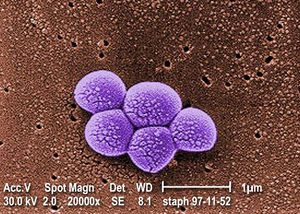Clostridium botulinum Neurotoxin: The Duality of a Microbe with Fatal and Therapeutic Applications
Section

By Firtnam Lastname
At right is a sample image insertion. It works for any image uploaded anywhere to MicrobeWiki.
The insertion code consists of:
Double brackets: [[
Filename: PHIL_1181_lores.jpg
Thumbnail status: |thumb|
Pixel size: |300px|
Placement on page: |right|
Legend/credit: Magnified 20,000X, this colorized scanning electron micrograph (SEM) depicts a grouping of methicillin resistant Staphylococcus aureus (MRSA) bacteria. Photo credit: CDC. Every image requires a link to the source.
Closed double brackets: ]]
Other examples:
Bold
Italic
Subscript: H2O
Superscript: Fe3+
Sample citations: [1]
[2]
A citation code consists of a hyperlinked reference within "ref" begin and end codes.
To repeat the citation for other statements, the reference needs to have a names: "Cite error: Closing </ref> missing for <ref> tag C. botulinum is made up of four different groups (I-IV), related by their collective ability to produce the neurotoxin botulinum.[3] Botulinum toxin has seven serotypes (A-G), most of which cause botulism, a neuroparalytic disease that can be fatal. There are several types of botulism, including food-borne, wound, infant, and iatrogenic botulism.[4]
Clostridium botulinum is an extremely biologically diverse microorganism, and can exist in a variety of different environments and conditions, especially due its highly heat resistant spores, which create the botulinum toxin. Botulinum neurotoxin is the most potent natural toxin known to science, and despite even very small doses being fatal, it also has several therapeutic applications. Its most common application is in the cosmetics industry, as botulinum toxin is the active ingredient in Botox®.[5] Overall, Clostridium botulinum is a truly unique microbe that has an extraordinary range of applications in our world.
Section 3
Include some current research, with at least one figure showing data.
Section 4
Conclusion
References
- ↑ Peck, M.W. (2009) “Biology and Genomic Analysis of Clostridium botulinum,” Advances in Microbial Physiology. Academic Press.Vol. 55, 183-320.
- ↑ Bartlett et al.: Oncolytic viruses as therapeutic cancer vaccines. Molecular Cancer 2013 12:103.
- ↑ [10.3389/fmicb.2016.01702 Brunt J., van Vliet A.H.M., van den Bos F., Carter A.T., Peck M.W. (2016) “Diversity of the Germination Apparatus in Clostridium botulinum Groups I, II, III, and IV,” Frontiers in Microbiology, 7.]
- ↑ Centers for Disease Control and Prevention. June 8, 2022. Botulism. U.S. Department of Health and Human Services.
- ↑ Nigam, P. K., & Nigam, A. (2010) “Botulinum toxin,” Indian journal of dermatology, 55(1), 8–14.
Authored for BIOL 238 Microbiology, taught by Joan Slonczewski,at Kenyon College,2024
